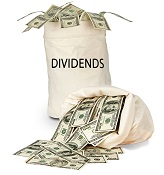Welcome to part two of the series on the best dividend paying stocks. In Part-1, we covered what a dividend is and where it comes from. Please go back and check out Part-1 if you need more background on dividends.
In Part-2 of the series on how to find the best dividend paying stocks, we’re going to focus on the investing risk spectrum, diversification, benefits of owning dividend paying stocks, and discuss why investing in dividend paying stocks can be an essential part of your stock portfolio.
Read on to learn why!
Risk Spectrum
With higher risk comes higher reward. We’ve all heard this mantra dozens of times in the investing world. But, just how much risk should one take with their investments? This question can only be answered by taking into account all the details of what the individual’s goals are for their investing journey. What I hope to do here is show you where dividend paying stocks fit on the risk spectrum. This will give you a better sense of the amount of risk you will incur with different types of investment mixes.
Did you notice that dividend paying stocks fall somewhere in the middle of the investment risk spectrum? Let’s move on to talk about how dividend paying stocks can help to increase or decrease the risk of your investment portfolio.
Investing Diversification
Ever hear the cliche: “don’t put all of your eggs in one basket?” Of course – we all have. The same thing applies to your investments. Putting all of your hard earned investment money in only one of these “baskets” (above) would be foolishness. If you can intelligently balance out your investment money into a number of different areas, you will be able to spread out the risk. This can protect you from “one-off” type events that could really harm your investments if you had all your money in just one basket. Here are just a few examples of what could go wrong – there are dozens of other ways you could be at risk with all your eggs in one basket!
- Cash – Inflation will chip away at your money 3%+ each year!
- Precious Metals – You can’t eat gold (just kidding – inside joke) – the precious metals market can be extremely volatile and could easily be cut in half in a number of weeks similar to what happened in 2008.
- Bonds – Interest rates could dramatically increase, lowering the value of existing bonds. Many fear this will happen when QE3 is tapered/pulled.
- Market Index Fund – The overall market could crash/correct (similar to 2008). This wouldn’t hurt you in the long-run unless you panic and sell off your stocks during the correction.
- Dividend Paying Stocks – The company could fall out of favor and eventually go bankrupt. The dividend could be cut, or the company could discontinue dividends all together if times get tough.
- Junk Bonds – Interest rates could dramatically increase, lowering the value of existing bonds. Also, if another financial downturn occurs bond repayment defaults could occur on these riskier bonds. This would drive the value of the junk bonds down.
- Growth Stock – The overall market could crash/correct. This type of phenomenon tends to impact “growth” type stocks more severely than market index fund ETFs. In addition, the company could fall out of favor, or it could go bankrupt. This is more likely for less established/newer companies.
- Penny Stocks – These are like buying lottery tickets. Very few actually appreciate and have enough liquidity that you can get your money back out at a profit. Most of the time you will lose your investment.
- Options – Good for “insurance” in your portfolio, but are highly leveraged trading instruments. You have to be correct about direction AND timing of stock/market moves. If you are wrong in either of these cases, you can lose your total investment.
- Derivatives and other highly leveraged instruments – If you make the wrong prediction, you stand to lose much more than your initial investment because of the leverage involved. Sometimes up to 20X! STAY FAR AWAY unless you’re an expert.
Dividend Paying Stocks – Risk Neutral?
You’ll notice that the best dividend paying stocks are generally pretty neutral on the “overall” spectrum of investments. What this means is that if you can use this to “pull” your portfolio one way or the other depending on the risk/reward you’d like to take.
If you’re heavy into cash/bonds and would like to increase your risk a bit, you can add some dividend paying stocks. Conversely, if you’re into really risky investments and would like to temper that a bit, you can buy the best dividend paying stocks to reduce the overall portfolio risk.
If you can pick a number of the best dividend paying stocks in different areas/sectors, and the total value of these only compromise 5%-10% of your overall portfolio, you’ll get that stock picking “urge” out of your system without taking on much risk. This will allow you to use the majority of your money (core assets) to invest in the boring old bonds and stock market index funds.
Because dividend stocks are not the riskiest of investments, your returns are more moderate than other types of risky investing. If you’re looking for a little more risk, you can always substitute some dividend paying stocks for growth stocks to give yourself more adventure. On the other hand, having a dividend paying stock with a predictable income stream can be great for folks that have a hard time tolerating high amounts of investment risk.
Other Benefits of Owning the Best Dividend Paying Stocks
Here are a couple of other benefits of owning the best dividend paying stocks that come to mind:
- For most of us in the US that own dividend paying stocks, we’ll pay only 15% taxes on the dividend income! This is how all those rich guys like Mitt Romney only end up paying an effective 14% income tax each year.
- These types of stocks are usually much less volatile that “growth” type of stocks. Because of this, they are well suited to folks that have a low to neutral risk tolerance.
- They naturally lead to more of a buy-and-hold type of strategy. This can help reduce the urge to participate in market timing, and can lead to lower brokerage fees.
- You can get compound returns on your money by reinvesting the dividends over time.
Best Dividend Paying Stocks – Part-2 – Final Thoughts
There you have it! I’ve given you several reasons why investing in the best dividend paying stocks can be an essential part of anyone’s investment portfolio. Investing in dividend paying stocks can be particularly attractive for those looking for a great way to increase or decrease the risk of a portfolio because when you pick the best dividend paying stocks, they are relatively neutral when it comes to risk.
Now that I’ve filled you with all of this background information on dividend paying stocks, it’s time to get into specifics! In the next part of our series we’ll be getting down to the nuts and bolts of how you’ll actually pick these best dividend paying stocks.
Click here to go back and read Part-1.
STAY TUNED FOR PART-3!!!










Pretty cool list. I personally don’t invest in dividend stocks, so I don’t really have any opinions to offer.
Troy recently posted…Why You Shouldn’t Invest in IPO’s